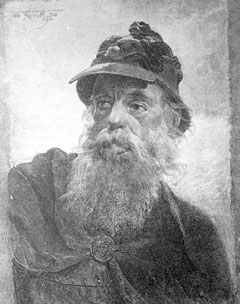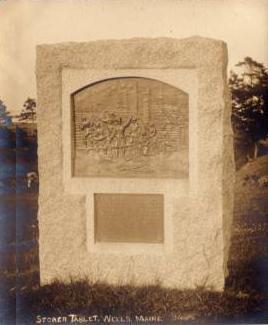
Penobscot Indian Island Reservation is an Indian reservation for the Penobscot Tribe of Maine, a federally recognized tribe of the Penobscot in Penobscot County, Maine, United States, near Old Town. The population was 758 at the 2020 census. The reservation extends for many miles alongside 15 towns and two unorganized territories in a thin string along the Penobscot River, from its base at Indian Island, near Old Town and Milford, northward to the vicinity of East Millinocket, almost entirely in Penobscot County. A small, uninhabited part of the reservation used as a game preserve and hunting and gathering ground is in South Aroostook, Aroostook County, by which it passes along its way northward.

King William's War was the North American theater of the Nine Years' War (1688–1697), also known as the War of the Grand Alliance or the War of the League of Augsburg. It was the first of six colonial wars fought between New France and New England along with their respective Native allies before France ceded its remaining mainland territories in North America east of the Mississippi River in 1763.

Dummer's War (1722–1725) is also known as Father Rale's War, Lovewell's War, Greylock's War, the Three Years War, the Wabanaki-New England War, or the Fourth Anglo-Abenaki War. It was a series of battles between the New England Colonies and the Wabanaki Confederacy, who were allied with New France. The eastern theater of the war was located primarily along the border between New England and Acadia in Maine, as well as in Nova Scotia; the western theater was located in northern Massachusetts and Vermont at the border between Canada and New England. During this time, Maine and Vermont were part of Massachusetts.

Jean-Vincent d'Abbadie de Saint-Castin (1652–1707) was a French military officer serving in Acadia and an Abenaki chief. He is the father of two prominent sons who were also military leaders in Acadia: Bernard-Anselme and Joseph. He is the namesake of Castine, Maine. He died at Pau, France, in 1707.
Joseph d'Abbadie de Saint-Castin was a French and Acadian military officer serving in Acadia. He was also an Abenaki chief.

The Battle of Port Royal occurred at Port Royal, the capital of Acadia, during King William's War. A large force of New England provincial militia arrived before Port Royal. The Governor of Acadia Louis-Alexandre des Friches de Menneval had only 70 soldiers; the unfinished enceinte remained open and its 18 cannon had not been brought into firing positions; 42 young men of Port-Royal were absent. Any resistance therefore appeared useless. Meneval surrendered without resistance not long after the New Englanders arrived. The New Englanders, led by Sir William Phips, after alleging Acadian violations of the terms of surrender, plundered the town and the fort.
Madockawando was a sachem of the Penobscot, an adopted son of Assaminasqua, whom he succeeded. He led the Penobscot on the side of the French against the English during King William's War.

The siege of Pemaquid occurred during King William's War when French and Native forces from New France attacked the English settlement at Pemaquid, a community on the border with Acadia. The siege was led by Pierre Le Moyne d'Iberville and Baron de St Castin between August 14–15, 1696. Commander of Fort William Henry, Captain Pasco Chubb, surrendered the fort. Iberville killed three of the soldiers and sent the other 92 back to Boston.

The Raid on Wells occurred during King William's War when French and Wabanaki Confederacy forces from New France attacked the English settlement at Wells, Maine, a frontier town on the coast below Acadia. The principal attack (1692) was led by La Brognerie, who was killed. Commander of the garrison, Captain James Converse, successfully repelled the raid despite being greatly outnumbered.

The siege of Pemaquid was a successful attack by a large band of Abenaki Indians on the English fort at Pemaquid, Fort Charles, then the easternmost outpost of colonial Massachusetts. The French-Abenaki attack was led by Jean-Vincent d'Abbadie de Saint-Castin and Father Louis-Pierre Thury and Chief Moxus. The fall of Pemaquid was a significant setback to the English. It pushed the frontier back to Casco (Falmouth), Maine.
The Northeast Coast campaign was the first major campaign by the French of Queen Anne's War in New England. Alexandre Leneuf de La Vallière de Beaubassin led 500 troops made up of French colonial forces and the Wabanaki Confederacy of Acadia. They attacked English settlements on the coast of present-day Maine between Wells and Casco Bay, burning more than 15 leagues of New England country and killing or capturing more than 150 people. The English colonists protected some of their settlements, but a number of others were destroyed and abandoned. Historian Samuel Drake reported that, "Maine had nearly received her death-blow" as a result of the campaign.

The Northeast Coast campaign (1745) occurred during King George's War from 19 July until 5 September 1745. Three weeks after the British Siege of Louisbourg (1745), the Wabanaki Confederacy of Acadia retaliated by attacking New England settlements along the coast of present-day Maine below the Kennebec River, the former border of Acadia. They attacked English settlements on the coast of present-day Maine between Berwick and St. Georges, within two months there were 11 raids - every town on the frontier had been attacked. Casco was the principal settlement.
The Northeast Coast campaign (1723) occurred during Father Rale's War from April 19, 1723 – January 28, 1724. In response to the previous year, in which New England attacked the Wabanaki Confederacy at Norridgewock and Penobscot, the Wabanaki Confederacy retaliated by attacking the coast of present-day Maine that was below the Kennebec River, the border of Acadia. They attacked English settlements on the coast of present-day Maine between Berwick and Mount Desert Island. Casco was the principal settlement. The 1723 campaign was so successful along the Maine frontier that Dummer ordered its evacuation to the blockhouses in the spring of 1724.
The Battle of Falmouth was fought at Falmouth, Maine when the Canadiens and Wabanaki Confederacy attacked the English New Casco Fort. The battle was part of the Northeast Coast Campaign (1703) during Queen Anne's War.

The Northeast Coast campaign of 1746 was conducted by the Wabanaki Confederacy of Acadia against the New England settlements along the coast of present-day Maine below the Kennebec River, the former border of Acadia. during King George's War from July until September 1746. They attacked English settlements on the coast of present-day Maine between Berwick and St. Georges, within two months there were 9 raids - every town on the frontier had been attacked. Casco was the principal settlement.

The Northeast Coast campaign of 1747 was conducted by the Wabanaki Confederacy of Acadia against the New England settlements along the coast of present-day Maine below the Kennebec River, the former border of Acadia. during King George's War from July until September 1747. They attacked English settlements on the coast of present-day Maine between Berwick and St. Georges, within two months there were 11 raids - every town on the frontier had been attacked. Casco was the principal settlement.
The Northeast Coast campaign of 1750 occurred during Father Le Loutre's War from 11 September to December 1750. The Norridgewock as well as the Abenaki from St. Francois and Trois-Rivières, Quebec raided British settlements along the Acadia/ New England border in present-day Maine.
The Northeast Coast campaign of 1675 was conducted during the First Abenaki War and involved the Wabanaki Confederacy raiding colonial American settlements along the New England Colonies/Acadia border in present-day Maine. Allied with French colonists in New France, they killed eighty colonists and burned many farms, blunting the tide of colonial British expansion in the north. Settlers deserted community after community, leaving only the settlements south of the Saco River to maintain an English presence in the region. Historian Georges Cerbelaud Salagnac writes, that Castine and the Abenaki “displayed consummate skill at it, holding in check at every point, from the Penobscot River to Salmon Falls, N.H., and even beyond, 700 regular troops, and even inflicting humiliating defeats upon them.” These raids were part of continuing warfare as the French and British fought for control in North America into the 18th century, as part of their rivalry in Europe.
The Northeast Coast campaign of 1676 took place during King Philip's War. It involved the Wabanaki Confederacy raiding colonial American settlements along the New England Colonies/Acadia border in present-day Maine. In the first month, they laid waste to 15 leagues of the coast east of Casco. They killed and captured colonists and burned many farms, blunting the tide of colonial American expansion. The campaign led colonists to abandon the region and retreat to Salem, Massachusetts. The campaign is most notable for Richard Waldron entering the war, the death of Chief Mog, and the attack on the Mi’kmaq that initiated their involvement in the war.
The Northeast Coast campaign of 1677 was conducted during the First Abenaki War and involved the Wabanaki Confederacy raiding colonial American settlements along the New England Colonies/Acadia border in present-day Maine. The Wabanaki killed and captured colonists and burned many farms, blunting the tide of colonial American expansion.








